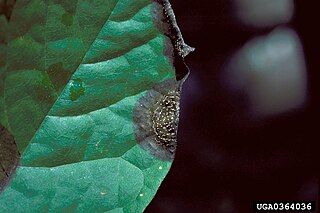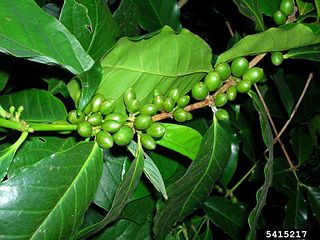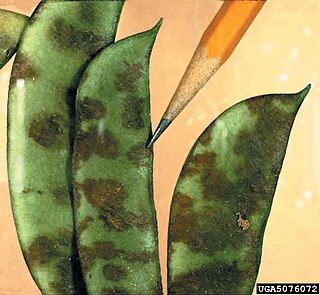Glomerella graminicola is an economically important crop parasite affecting both wheat and maize where it causes the plant disease Anthracnose Leaf Blight.

Colletotrichum acutatum is a plant pathogen and endophyte. It is the organism that causes the most destructive fungal disease, anthracnose, of lupin species worldwide. It also causes the disease postbloom fruit drop on many varieties of citrus, especially Valencia and navel oranges in Florida.
Colletotrichum trifolii is a fungal plant pathogen of alfalfa, causing the disease alfafa anthracnose. It is a biotroph, obtaining nutrients from the living plant cells before forming asexual spores. This fungus has two known races Bain and Essary.

Colletotrichum kahawae is a fungal plant pathogen that causes coffee berry disease (CBD) on Coffea arabica crops. The pathogen is an ascomycete that reproduces asexually. The asexual spores (conidia) are stored within acervuli. This disease is considered to be one of the major factors hampering C.arabica production in the African continent, which represents the current geographic range of the fungus. Coffee berry disease causes dark necrosis in spots and causes the green berries of the coffee to drop prematurely. High humidity, relatively warm temperatures, and high altitude are ideal for disease formation. Given the severity of the disease and the lack of effective control measures, there is great concern that the fungus may spread to other coffee producing continents, such as South America, which could have catastrophic consequences.

Didymella bryoniae, syn. Mycosphaerella melonis, is an ascomycete fungal plant pathogen that causes gummy stem blight on the family Cucurbitaceae, which includes cantaloupe, cucumber, muskmelon and watermelon plants. The anamorph/asexual stage for this fungus is called Phoma cucurbitacearum. When this pathogen infects the fruit of cucurbits it is called black rot.
Colletotrichum capsici is a species of fungus and plant pathogen which causes leaf blight on Chlorophytum borivilianum, basil, chickpea and pepper as well as dieback in pigeonpea and anthracnose in poinsettia.

Colletotrichum coccodes is a plant pathogen, which causes anthracnose on tomato and black dot disease of potato. Fungi survive on crop debris and disease emergence is favored by warm temperatures and wet weather.

Colletotrichum lindemuthianum is a fungus which causes anthracnose, or black spot disease, of the common bean plant. It is considered a hemibiotrophic pathogen because it spends part of its infection cycle as a biotroph, living off of the host but not harming it, and the other part as a necrotroph, killing and obtaining nutrients from the host tissues.

Colletotrichum orbiculare is a plant pathogen of melons and cucumber. It causes the disease anthracnose that can effect curcubits causing lesions on various parts of the plant. It can effect cucumbers, melon, squash, watermelon and pumpkin, especially when the weather is rainy, humid and warm. It can be transmitted by seed as well as soil and survive between crops. It is also spread by feeding cucumber beetles, splashing water, tools and workers. Efforts to control the fungus include the practice of rotating cucurbits out for a 2-year period, planting cultivars with resistance, burning infected crops and careful control of weeds. Chemical control measures are also available.

Glomerella cingulata is a fungal plant pathogen, being the name of the sexual stage (teleomorph) while the more commonly referred to asexual stage (anamorph) is called Colletotrichum gloeosporioides. For most of this article the pathogen will be referred to as C. gloeosporioides. This pathogen is a significant problem worldwide, causing anthracnose and fruit rotting diseases on hundreds of economically important hosts.
Colletotrichum fragariae is a fungal plant pathogen infecting strawberries. It is not a well known fungus, and there are many similar fungi that are related to it. It is part of the Colletotrichum genus. It is a pathogen that occurs in strawberries. It leads to the disease known as anthracnose. This is typically at the crown of the strawberry, which is why it is often called crown rot. It is also known as the Anthracnose Crown rot. The fungus also infects leaves and is known as leaf spot, which is common among all Colletotrichum. This is not as common in the fragariae, as it is more common in the crown. This fungus is also better at infecting younger strawberries/seedlings. The most common way to control this disease is fungicides that are harmful to the environment. There have been studies done to see if the fungus infects other hosts but other than some weeds, it is very specific to Strawberries.
Colletotrichum cereale is a plant disease (fungus) that has been found to cause crown rot anthracnose of turf grass most commonly occurring on golf courses. Anthracnose can occur as both a foliar blight and basal rot. This disease attacks the crowns of plants, which is different than other anthracnose diseases. Anthracnose of turfgrass can be a foliar disease or in this case a basal rot of the lower portion of the plant. It attacks different species of turfgrass throughout the world most commonly annual bluegrass and creeping bentgrass.
Pecan anthracnose is a fungal disease of pecan trees caused by the ascomycete Glomerella cingulata (Stoneman) Spauld. & H. It is a widespread disease found wherever pecan trees are grown. Pecan anthracnose has been reported as far back in time as 1914, and as far away as Argentina. Glomerella cingulata has two anamorphs which cause disease on pecan trees, Colletotrichum gloeosporioides and Colletotrichum acutatum. The occurrence of Colletotrichum on pecans has contributed to a significant decline in pecan production in various years. An increase in the incidence of pecan anthracnose is highly correlated with heavy rainfall, especially heavy rainfall occurring in early spring. The severity of symptoms increases as the season progresses, often culminating in leaf drop in the late autumn. This defoliation is linked to lower yield and poorer quality of nuts.
Colletotrichum nicholsonii is a falcate-spored graminicolous plant pathogenic fungi species, first isolated from warm-season grasses.
Colletotrichum paspali is a falcate-spored graminicolous plant pathogenic fungi species, first isolated from warm-season grasses.
Colletotrichum jacksonii is a falcate-spored graminicolous plant pathogenic fungi species, first isolated from warm-season grasses.
Colletotrichum miscanthi is a falcate-spored graminicolous plant pathogenic fungi species, first isolated from warm-season grasses.
Colletotrichum axonopodi is a falcate-spored graminicolous plant pathogenic fungi species, first isolated from warm-season grasses.

Colletotrichum fioriniae is a fungal plant pathogen and endophyte of fruits and foliage of many broadleaved plants worldwide. It causes diseases on agriculturally important crops, including anthracnose of strawberry, ripe rot of grapes, bitter rot of apple, anthracnose of peach, and anthracnose of blueberry. Its ecological role in the natural environment is less well understood, other than it is a common leaf endophyte of many temperate trees and shrubs and in some cases may function as an entomopathogen.

Bitter rot of apple is a fungal disease of apple fruit that is caused by several species in the Colletotrichum acutatum and Colletotrichum gloeosporioides species complexes. It is identified by sunken circular lesions with conical intrusions into the apple flesh that appear V-shaped when the apple is cut in half through the center of the lesion. It is one of the most devastating diseases of apple fruit in regions with warm wet weather.








